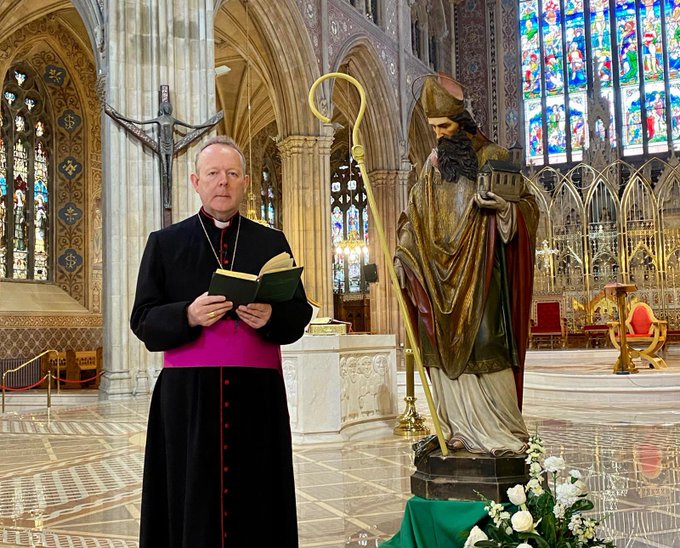Below is the Easter Sunday Homily of Archbishop Eamon Martin, Archbishop of Armaugh.
I am “conscious this year of the victims of the Covid crisis, including those who are finding it more and more difficult to cope with lockdown: the lonely and bereaved; those who are unable to see or embrace loved ones; those for whom the last year has brought increased financial or business worries; those whose relationships have been under great pressure; those who have found their addictions hard to manage” – Archbishop Martin
Homily
A commentator on radio this week suggested it may be a long time before we return to the forms of greeting and embrace we were used to before the pandemic – even to shaking hands.
We do miss the closeness – especially with our loved ones – but we probably will be more wary and standoffish when it comes to meeting casually, or with strangers. Elbow nudges are likely here to stay!
Two stories from the Easter Gospels highlight the importance of touch.
After the Resurrection, the apostle Thomas refused to believe that the Risen Lord was real. But Jesus invited the so-called “Doubting Thomas”, to touch the wounds in His hands and side. “Put your finger here; look, here are my hands. Give me your hand; put it into my side. Doubt no longer, but believe” (Jn 20:28).
Thomas, now satisfied by touch that the Risen Lord was physically present to him, made a profound expression of faith: “My Lord and my God”.
Strangely, however, just a few verses earlier in John’s Gospel, we read about Mary Magdalene who recognizes the Risen Lord on Easter morning and reaches out to embrace Him. This time Jesus says in that famous Noli me tangere moment: “Do not cling to me (Mary) for I have not yet ascended to my Father (Jn 20:17)”. It must have seemed strange to her because she was so close to Jesus. She also knew that Jesus was comfortable with touch.
Only a few days previously at the Last Supper, Jesus had bent down to wash the feet of His disciples. Mary Magdalene had witnessed His touching the diseased skin of lepers, seen Him lay His hands on the dying, reach out to touch and heal eyes and ears and limbs. People wanted to touch even the hem of His garments in order to experience His healing presence.
Perhaps Jesus was teaching Mary Magdalene something, telling her it was time to let go of His physical presence with her, for He must return to the Father as if to say ‘Do not cling to me but do not be afraid. I will still be with you’.
In those days after the Resurrection, it must have been very difficult for those who didn’t actually get to see and touch the Risen Christ, to accept the testimony of witnesses that Jesus was alive.
Hence those words: “Happy are those who have not seen and yet believe.”
For all of us, there are moments when we are confident that God is present with us – sometimes so close that we feel we could almost reach out and touch Him. But there are also days when God seems distant and we long for tangible signs of God’s presence to cling to.
Believing in God sometimes involves uncertainty. We have to live with doubts and questions, to struggle with insecurity, to manage bitter disappointments and personal crises, all the time hoping for some light from God to enlighten our darkness and lift our sense of aloneness and isolation.
But God’s grace is often to be found in that struggle, perhaps not to actually see, and yet believe. Saint John Henry Newman put it powerfully when he wrote faith is to “reach forth after truth amid darkness.”
During Holy Week we walked the Way of the Cross with Jesus, bringing with us our own struggles and the sufferings of others: those who wrestle with illness and pain, who daily endure doubt, anxiety or depression. We are especially conscious this year of the victims of the Covid crisis, including those who are finding it more and more difficult to cope with lockdown: the lonely and bereaved; those who are unable to see or embrace loved ones; those for whom the last year has brought increased financial or business worries; those whose relationships have been under great pressure; those who have found their addictions hard to manage.
The dawn of Easter morning marks the promise that pain and suffering can never be allowed to overwhelm us or have the last word. Christ our Lord is Risen. It is His light that dispels the darkness of our hearts and minds and offers the reason to keep on living, the reason to keep on hoping amidst the struggle.
Of course, there are times, like Thomas, when we would like proof, to be able to see His Resurrection with our own eyes, to reach out and touch Him, to cling to Him.
The Risen Lord promised, as He was taken up to heaven: “Know that I am with you always, until the end of time” (Mt 28:20).
We are asked, in return, to say in faith, “My Lord and my God” knowing that, as the letter to the Hebrews reminds us: “Only faith can guarantee the blessings that we hope for, or prove the existence of the realities that at present remain unseen” (Heb 11:1).
Happy Easter everyone. Christ is Risen. Alleluia. He is Risen indeed. Alleluia, Alleluia!
- Archbishop Eamon Martin is Archbishop of Armagh, Apostolic Administrator of the Diocese of Dromore, and Primate of All Ireland.










